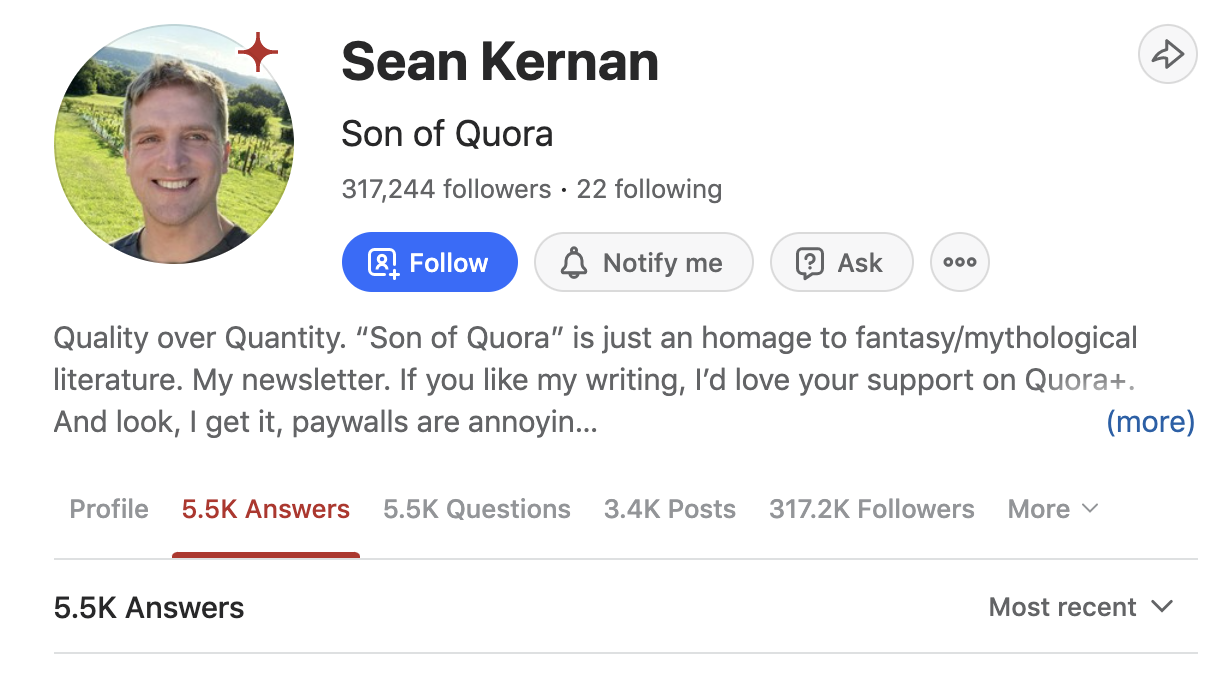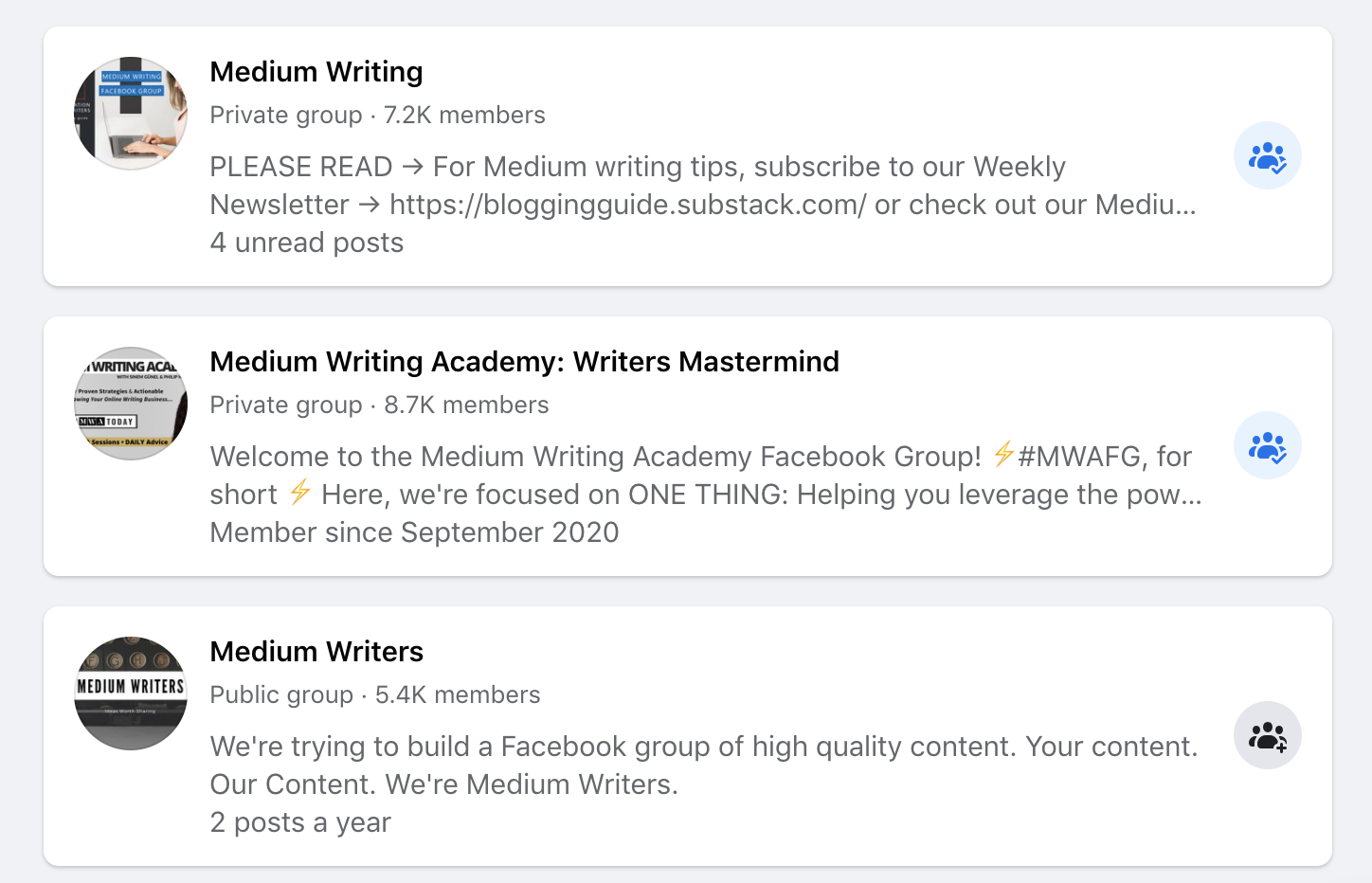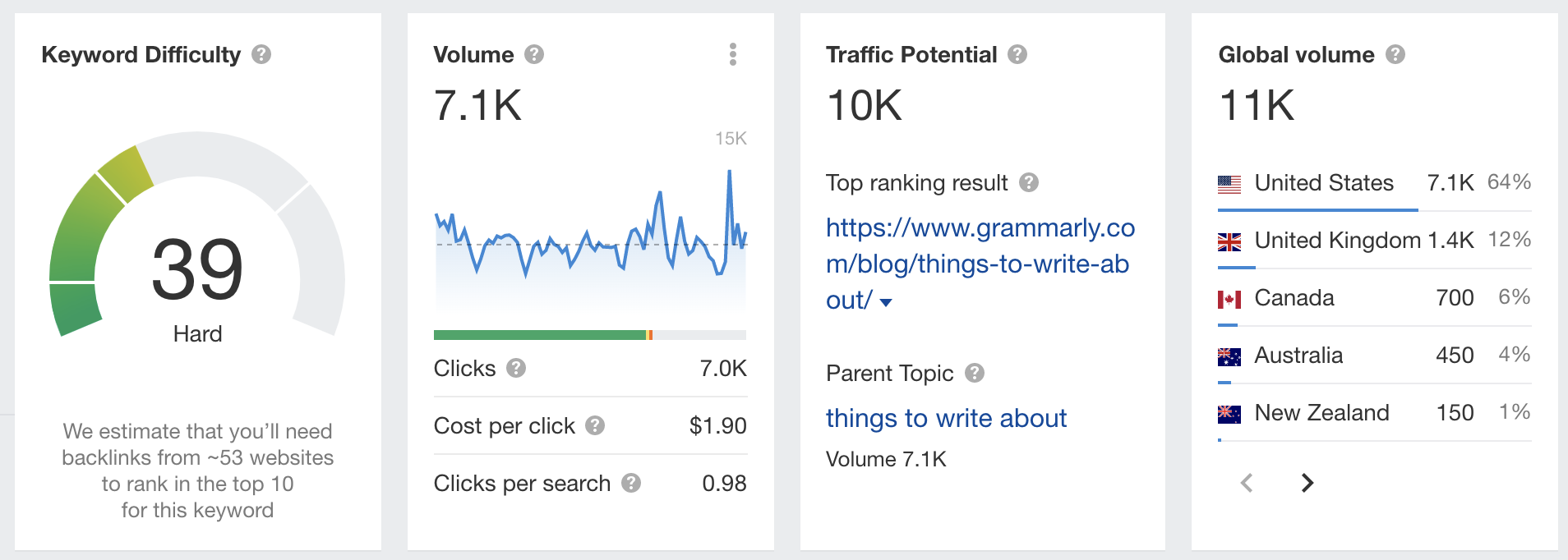
Never Run Out of Things to Write About: The Ultimate Guide
Featured Download: Never Run Out of Things to Write About Again: The Ultimate Guide. Grab a PDF version of this blog post here to save and read later.
Most aspiring writers tell me they struggle with finding things to write about.
Either they have no idea where to start or they feel burnt out because they’ve been writing for a while and it feels like they’re repeating themselves.
For both camps, this is a crucial problem to solve.
If you don’t have things to write about, you can’t build a body of work. Without a body of work, you can’t build a big-enough audience to support your writing career.
If you run out of ideas for topics to write about, then you have nowhere to turn.
Let’s fix this problem once and for all.
This post is going to be so good that if you still can’t come up with ideas for things to write about, you should quit writing.
Who This Post Is For
Before we dive into the tips, I want to make sure this guide is right for you. I teach a specific type of blogging style that only works for people who fit certain parameters.
If you fit the following, this post on things to write about is a good fit for you:
- You write non-fiction content: I don’t teach fiction, but here are some good resources for those looking to write it
- You write advice-driven content: Personal essays aren’t my forte, although I am very good at them and have multiple guides for those of you who want to write about yourself
- You’ve already chosen a niche: This post is for people looking for things to write about in a broader topic they’ve already picked. Here are some guides on finding a niche. After you’ve read through those and have something locked in, come back to this post.
If you fit all the above, you’re the type of writer who’s in a position to turn your hobby into a career and monetize your work.
Come up with enough things to write about and you’ll be able to build an audience that you can educate and help while building your dream at the same time.
Let’s dive in.
Most Writers Skip This Step When Finding Things to Write About
This step is obvious, simple, and doesn’t take a ton of work, but most writers skip this step for one simple reason.
They are lazy.
If you take this step, it’ll be much easier to find writing topics and you’ll develop an intuitive sense of how to come up with topics over time.
I could sit down and write a blog post idea off the top of my head because I have an important grasp of this useful concept.
If you want to come up with an endless number of blog posts topics, first create a deep understanding of your reader.
This won’t just help you come up with things to write about, it’ll give you the seeds for virality. The better you understand your reader the easier it is to write things they want to read.
Simple, obvious, yet missed by most newbie writers.
Many of my readers say it feels like I’m reading their minds. I can ‘read minds’ because I did the dirty and boring work of audience research.
Your ability to do boring work, the stuff you don’t want to do, is the key to building your writing business.
If you’re ready to stop being an amateur, roll up your sleeves and do exactly what I’m about to tell you to do.
Ask Yourself This Question to Come Up With Things to Write About For Your Audience
What keeps your readers up at night? My blogging mentor, Jon Morrow, taught me to ask this question to figure out how to come up with blog post ideas.
A quote from my blogging sensei:
You’ve probably heard you need to profile your prospect, see the story through the eyes of your reader, or do your best to listen to people. But how many of us actually do that?
We write down a few demographic facts about our prospects, or we read a few letters from our readers, or we spend a few minutes listening to a coworker, and we think we understand them.
But we don’t. To really understand people, you need to know what keeps them awake until 2 AM, tossing and turning and unable to sleep.
You want to focus on these two angles when it comes to audience research:
- Fears/frustrations: What keeps your reader up because they’re worried? What bothers them the most? What’s their deepest pain point and most pressing problem?
- Hopes/aspirations: What transformation does your reader want to make? What does their ideal life look like? What are their biggest and most audacious goals?
Use the answers to these questions to come up with things to write about using this framework.
Step 1: Create lists of both fears/frustrations and hope/aspirations
The more detailed and lengthy your list, the more potential blog post ideas you have and the deeper your understanding of the reader becomes.
When I learned this from Jon, he said to write down a list of 20 for each angle. I believe I ended up writing 50 just for good measure.
Phrase them using the word “I” so you see things from the reader’s angle
Examples of fears/frustrations (writing niche):
- I struggle to find things to write about
- I’m afraid I’ll never build a big-enough audience to support my work
- I get writer’s block often when I sit down to write
Examples of hopes and aspirations:
- I want to become a best selling author
- I want an audience of fans who love my work
- I’d love to make a full-time living as a writer
Step 2: Create solutions based on all the above
Headlines are the bedrock for popular articles. If people don’t click on your headlines, they can’t get to your awesome content.
This framework helps you attract readers because your headlines will directly address their needs.
Write a list of solutions and positive outcomes for every fear/frustration and hope/aspiration you wrote down.
Examples:
- I found a topic selection and research system that helps me easily find things to write about
- I discovered a reliable process for attracting and retaining an audience
- Using a mind-map and outline technique, I never wonder what to write about anymore
- I’ve sold 1,000 copies of my book
- I built an email list of 1,000 subscribers who love to read my posts
- I built a full-time business from writing and make a six-figure income
Step 3: Write Headlines Based On Those Solutions and Outcomes
By the end of the process, you’ll have headline ideas that genuinely meet your reader’s needs.
Take the outcomes and solutions and fit them into useful frameworks. My most reliable headline frameworks are how-to posts and listicles.
Beginner writers would do well just to focus on those two headline styles until they get the process nailed down.
Headline examples:
- How to Find Things to Write About: The Ultimate Guide (notice how the idea for this and headline follow the framework)
- The Ultimate Guide to Attracting a Loyal Audience of Readers. This is a post I wrote using this framework
- 7 Proven Techniques to Defeat Writer’s Block Once and For All
- How to Make Money with Kindle Direct Publishing [Case Study]. A guide I wrote for Smart Blogger.
- How to Grow Your Email List to 1,000 Subscribers in 90 Days or Less
- How to Become a Writer and Make a Living With Your Words. Another guide I wrote using this framework.
If you wrote 40 headline ideas based on this exercise, you’d have 40 headlines, which is enough content to last you months.
And we’re just getting started on this guide to coming up with things to write about.
Find Out Where Your Readers Hangout and Steal Their Words
I learned how to create the ‘mind reading’ effect because I took the time to figure out what my readers wanted by spying on them.
I went to where they hung out and watched the words they used to describe their fears/frustrations and hopes/aspirations.
Sometimes, I’d swipe exact phrases and use them in my headlines, copy for emails and sales pages, or inside my blog posts themselves.
Don’t guess. Go to where your readers are and see what they’re saying. Here are some places you can do digging.
Amazon.com
Amazon has the world’s largest bookstore, which makes it an excellent place to hunt for things to write about.
Go to Amazon, search for books in your niche, and read the reviews of popular books.
I prefer to use three-star reviews because they tend to be the most honest and accurate.
Often, five-star reviews come from loyal fans who love everything the author puts out so they’re biased.
One-star reviews are too negative and usually just trash the writer themselves instead of the content.
Three-star reviews are like pros and cons lists. You can use reviews to figure out what’s popular and where the gaps in the market are.
Take this review:

Analyzing this as a writer who talks about self-defeating behaviors, I could glean the following insights:
- Write articles that solve a very specific problem, e.g., how to remove toxic people that harm you from being in your life
- Create articles based on each of the ’10’ things you can learn from self-defeating behaviors using your own unique spin
- Write in-depth tactical guides on mental health issues
- Write an article on ‘signs you exhibit self-defeating behaviors
- Use a direct and to the point style for topic selection & writing, e.g., Simple and Proven steps to solve self-defeating behaviors
This is just a quick and dirty example, but you can use this process to create a deeper understanding of your reader and come up with things to write about at the same time.
Quora.com
Quora is a q&a site for people looking for answers to specific questions. Anybody can post questions and anyone can write answers to those questions.
It’s a perfect place to figure out exactly what’s on your reader’s mind. If you master Quora, you’ll learn how to write about topics people want to read.
That’s exactly what my friend Sean Kernan did. A few years back he started writing on Medium and found success almost instantly.

His ‘internship’ on Quora helped him come up with ideas to write about on Medium and helped him get good at knowing what readers want, period.
He did the work most beginners won’t do. To date, he’s written more than 5,500 answers on the website. All for free, too.
If you want to get good at coming up with things to write about you have to practice relentlessly.
You can’t skip the work.
For a while, I used Quora to source ideas for blog posts by taking the questions people asked and turning the answers into blog posts.
Then, I’d use the question to come up with the headline. I wrote this viral blog post below by answering the question “What are some really small things that tell you a lot about someone?”

Facebook Groups
Facebook groups can help you come up with things to write about because people use these groups to get their problems solved or reach their goals.
Sticking with the writing niche as an example, you could come up with topic ideas by engaging in Facebook groups for writers:

You could look at the posts people make and questions they post to the group. You can also look at the responses people make to posts from the group admin.
Taking it a step further, the best way to use a Facebook group to source content ideas is actually being an engaged member of the group.
Post in the group, ask questions, answer questions from other group members.
Never try to sell your products, pitch services, or promote your own blog in these groups.
Use them for research purposes only and to make real connections with people.
Blog Post Comments
Blog post comments are another way you can swipe the exact phrases your readers use and add them to your writing.
Also, you can source new ideas by making posts based on things your readers say they want to learn more about.
Let’s say you’re blogging on Medium (which all of you should be). You can use the site to find an endless number of comments you can source from because it gets so much traffic.
First, you can read your own comments. Pro tip: add a call to action at the end of your posts that ask readers to comment with ideas they want you to write about.
You can also spy on other top writers and posts in your niche for ideas.
Choose a tag you use frequently for your Medium posts:

Go to the page for that tag:

Find top blog posts for that tag (they’ll have the most comments):

Read the comments and glean insights similar to the way I taught you to do so on Amazon. You can also use the top post themselves as inspiration.
Never plagiarize, but look at things you can swipe like headline structure, topic selection, and post styles that work well.
I could stop right here when it comes to finding things to write about, but this is the ultimate guide to coming up with things to write about so let’s keep going.
Creating a deep understanding of your readers alone will help you easily come up with writing topics, but these tactical tips can take your content research to the next level.
Become a top writer on Medium and make money writing with this free five-day email course.
Create a Go-To Resource For Things to Write About
Most newbies struggle to come up with content ideas because they wait until they sit down to write to come up with an idea.
They tell themselves they’re going to write something that day, but they don’t know what.
Then they just sit there staring at the blank page because they didn’t do any pre-work beforehand.
Pro writers have a headline bank: A list of headline ideas they’ve carefully curated over time.
When they sit down to write, they can choose from a list of ideas they’ve already researched.
Imagine having 100 blog post ideas you really like that are ready to go. Think it would be easier to sit down and write something?
A foundation of ideas + coming up with new ideas daily = a never-ending stream of ideas.
Let’s take a look at some strategies you can use to build your headline bank.
My Favorite Strategy to Come Up With Interesting Things to Write About
I’ve written about this strategy ad nauseam, so I’m just going to steal a description I used in a previous post:
I stole from James Altucher and I’ve mentioned it in several dozen blog posts at this point. It’s worth repeating because it works.
Here’s how the idea machine technique works. Write down ten ideas for blog post headlines every day.
To this day, only two or three of the headline ideas are good. Only one in a handful of sessions is great.
A few have become the seeds for legendary viral posts that built my career. But I never knew when the greatest ideas would come. I just worked at them every day.
The Notecard Strategy
Great writers are great readers.
Reading a lot and reading widely between different subjects feeds your brain with useful information and helps you come up with unique ideas for things to write about.
Problem is, you don’t retain much of what you read.
Enter the notecard strategy. I learned about this technique from best-selling author Ryan Holiday who learned about it from mega best-selling author Robert Greene.
In short, you read a book, highlight insightful quotes/ideas, then write them down on notecards and organize the cards by broader topics.
You can also jot down ideas and insightful quotes you just happen to pick up throughout your day.
Here’s an excerpt from the full post that details the strategy:
As you compile cards and study different things, it’s not uncommon to organically begin coming across unexpected themes. This is how new categories are born.
The 70/20/10 Rule
I learned this technique from Sean Kernan.
Here’s how the 70/20/10 rule works:
- 70 percent of your content should be the subject matter that’s well within your wheelhouse
- 20 percent of your content should be off the wall stuff you’re not used to writing
- 10 percent of your content should be really off the wall, borderline embarrassing to publish
From Sean himself:
Each writer eventually develops a core group of readers, sometimes one or a two, sometimes many more. These people will read most of what we write. They are our VIPs. It’s upon us to ensure we aren’t being too cookie-cutter or going through the motions.
Use Your Catalog to Build Your Catalog
Most writers don’t get much mileage out of their content. They post something once and then never use that post as a resource ever again.
Smart writers use the work they’ve already created to their advantage. Here’s an example from yours truly.
Remember that post I wrote using a Quora answer? It was called 8 Really Small Things That Tell You A Lot About Someone.
I noticed that a bunch of readers loved one point in particular — how people trait retail, waitstaff, and service workers.
Instead of struggling to come up with a viral idea, I took the most popular point from a viral blog post and create a new post focused solely on that point.
This led to me writing One Small Thing That Tells You A Lot About Someone. The title has a similar structure to the viral piece — if it ain’t broke don’t fix it.
Also, I suspected it would do well because it touched on the favorite item from the previous list. Rarely do I know a post will be a hit, but with this one I did. It worked out exactly the way I thought it would.
Some other ideas for using your catalog to build your catalog:
- Create a case study on a subject you’ve previously written about
- Expand my technique and write a new blog post for every single item you used in a popular listicle
- Take many small blog posts and turn them into an ultimate guide
- Write ten ideas for headlines using the same structure of popular blog posts, e.g., 8 Really Small Habits that Make a Big Difference in Your Life
See how this works? I took a Quora answer, turned it into a viral blog post, and used that viral blog post to create another blog post.
Find things to write about by using what you already wrote.
Use Content Research Technology
There are a bunch of different tools online that can help you come up with ideas for things to write about.
Some tools focus on search engine optimization. Using SEO tools kills two birds with one stone.
You get to find topic ideas that people are already looking for so you know they’re good ideas. And you can get traffic from search engines.
For the remainder of 2022, I’m making a huge bet on SEO. I’ll show you one of my strategies then I’ll point you to other popular resources as well as guides to use them.
I use a software called Ahrefs for SEO research. It’s pricey to some, but it’s also one of the most advanced and useful tools for SEO research.
I used Ahrefs to come up with the idea for this post. Here’s how I did it.
First, I choose a competitor to spy on. I see what they’re ranking for and I (try to) write better versions of their posts.
For this post, I plugged my mentor’s website into the tool:

Next, I used the organic keywords tool to see what words the site ranks for. I used the following filters because I wanted to write something that had a shot at ranking:

- I choose keywords with a maximum keyword difficulty of 40. Any higher than that and I’m competing against sites that have way more authority than I do.
- I choose keywords with no more than 10,000 searches per month. Again, I’ve found this to be a good filter to find words my Medium-sized blog can rank for.
- Then I filter by volume so I can see the ideas with the most potential first

There are a couple of advanced filters I might look into as well, but this process is more than good enough for a beginner.
Here are some guides on using Ahrefs:
- How to Use Ahrefs: 11 Actionable Use Cases for Beginners
- Content Creation: The Complete Guide for Beginners
- Content Explorer: Discover and analyze top-performing content in your niche
There are a few other tools I’ve used before as well that can help you find things to write about:
The Recap + Final Thoughts
If you’ve made it to the end of this post, you now have more than enough information to come up with things to write about.
I taught you how to create a deep understanding of your reader first so you can come up with things to write about later.
I taught you my mentor’s content research question “What keeps your readers up at night?” and his strategy for turning those answers into solutions and finally headlines.
You learned how to use online resources for audience research like Quora, Facebook Groups, Amazon, and Medium.
After gaining a bunch of valuable insights to help you understand your reader, I gave you proven tactics to generate ideas and fill up your headline bank.
And I even through in content marketing research tools that tell you exactly what people want to read.
You have no excuses.
Here’s my parting thought…
Tactics and strategies are great, but they’re useless without the mindset needing to execute them.
This mindset I’m about to share with you will help you turn pro and stop struggling to come up with ideas.
Ready?
If you want to come up with great ideas, it must become your job to find them. No, scratch that, it must become your duty and never-ending mission to find them.
Readers always ask me how I appear to be this writing machine that never runs out of things to say. They want the magic formula, but instead, I tell them the truth.
I’ve worked on coming up with good ideas, nearly every single day, for seven years straight without quitting or taking a break.
I’ve written more than 20,000 headline ideas. Most were bad, but a handful of gems helped me get a whole lot of views and a bunch of money.
I did what most other writers just won’t do. I read detailed guides like this and actually implemented the information. Most writers are too lazy to read a 3,5000-word post so there’s no way they’re going to write them.
I’ve spent thousands on my own blogging education. I studied the top writers in my field relentlessly. I decided that come hell or high water I was going to write for a living.
That’s the kind of attitude and dedication it takes to make it in this game. Anything short of that won’t cut it.
Get to work.
Want people to, you know, actually, click on your articles and read them? Grab the headline vault here — 50+ headline ideas and templates you can use to write viral hits.